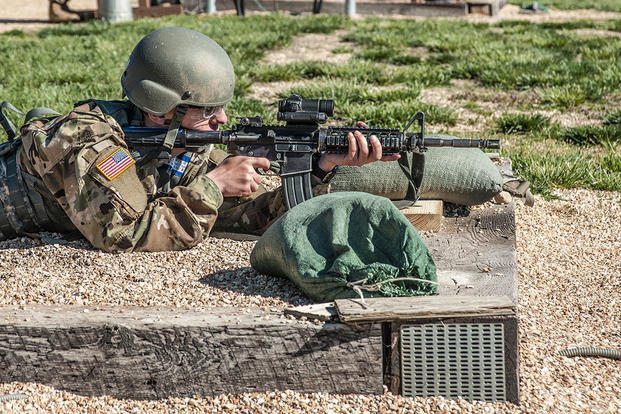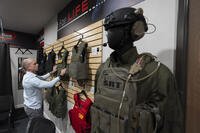U.S. Army training officials have finalized a plan to ensure new recruits in Basic Combat Training receive more trigger time on their individual weapons.
In the past, new soldiers would learn to shoot their 5.56mm M4 carbines and qualify with the Army's red-dot close combat optic. Under the new marksmanship training effort, soldiers will qualify on both the backup iron sight and the CCO, as well as firing more rounds in realistic combat scenarios.
"We just want to make sure at the end of the day, they can still pull that weapon out and engage the enemy effectively," Col. Fernando Guadalupe Jr., commander of Leader Training Brigade at Fort Jackson, South Carolina, told Military.com.
Guadalupe's brigade, which falls under the Center for Initial Military Training, is responsible for the new training program of instruction for Basic Combat Training that the Army announced earlier this year.
The new BCT is designed to instill more discipline and esprit de corps in young soldiers after leaders from around the Army noted trends among soldiers fresh out of training displaying a lack of obedience, poor work ethic and low discipline.
The restructured training program will place increased emphasis on marksmanship training and other combat skills.
Army Chief of Staff Gen. Mark Milley tasked Fort Jackson to lead the effort to toughen standards so soldiers will be more prepared for combat upon completion of BCT, Guadalupe said.
"He wanted us to create the absolute best soldier that we can create coming out of Basic Combat Training prior to their advanced individual training," he said.
Fort Jackson has been tasked to develop "best practices as we slowly implement the new program of instruction," Guadalupe said.
The goal is to have initial operating capability by July 15 and to have the new BCT fully operational at Jackson and the other three BCT centers at Fort Benning, Georgia; Fort Sill, Oklahoma; and Fort Leonard Wood, Missouri, by Oct. 1, he said.
The redesigned BCT marksmanship program includes more instruction time and requires trainees to spend more time on the range.
In the past, new soldiers in BCT shot 500 rounds and received 83 hours of marksmanship instruction over a 16-day period. The redesigned standards have soldiers shooting 600 rounds and receiving 92 hours of training.
Much of that time will be devoted to shooting and qualifying with front and rear backup iron sights to ensure soldiers become more familiar and more disciplined with their weapons, Guadalupe said.
Trainees start out working in marksmanship simulators, "but the real difference is made when they feel the percussion of that weapon and the effect that it has once actually shooting bullets down range," he said.
For nearly two decades, soldiers have relied upon sophisticated weapons optics such as the M68 CCO as the primary sight in combat.
But Army senior leaders, for many months now, have been stressing the importance of making sure soldiers can operate in technology-degraded environments since potential enemies such as Russia and China are investing in electronic warfare.
In addition to giving recruits more range time, this new reality is driving the return to learning to shoot with basic iron sights designed to work in any condition.
"While technology is critically important to us, we've got to make sure they understand the minimum basics of how you shoot that weapon without any of the technology that you could put on it," Guadalupe said.
Basic trainees will have to qualify with both iron sights and the CCO as a graduation requirement. For the qualification course, soldiers are still given 40 rounds to engage 40 targets.
But on CCO qualification day, soldiers will run through the course twice to give them more time to become effective with the optic.
"We did that so they would have more range time, more bullets for that CCO," said Wayne Marken, quality assurance officer at Jackson.
"They spend the predominance of training time on the backup iron sight, and because they complete backup iron sight and then transition to CCO, we have built in extra time for them to get more range time," he said.
The best qualification score soldiers receive during the CCO record firing day will determine which marksmanship badge they wear -- marksman, sharpshooter or expert.
"Let's say you go out and shoot 37 rounds and you are an expert the first time you qualify," Guadalupe said. "We are still going to let you go back to the range and shoot again."
The new emphasis on marksmanship is also designed to expose young soldiers to more realistic shooting scenarios.
At the end of the final field training exercise known as The Forge, soldiers are required to do a battle march and shoot event.
Soldiers march four miles with 40-pound rucksacks and then go immediately into a close-combat firing range, do 25 pushups and engage 40 targets at ranges out to 100 meters with 40 rounds of ammunition.
"This is at the end of The Forge, so the soldiers over a four-day period ... have marched over 40 miles already," said Thriso Hamilton, training specialist for the Basic Combat Training POI.
"The soldiers are extremely tired, they are hungry, they're under a stressful situation and we want to see at that point how much focus they can garner to be able to ... engage targets," he said.
-- Matthew Cox can be reached at matthew.cox@military.com.













